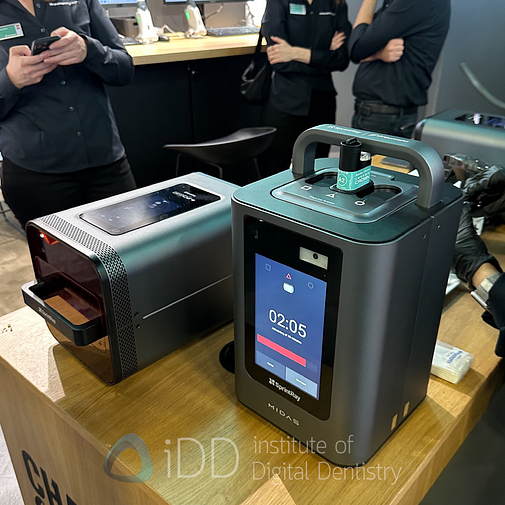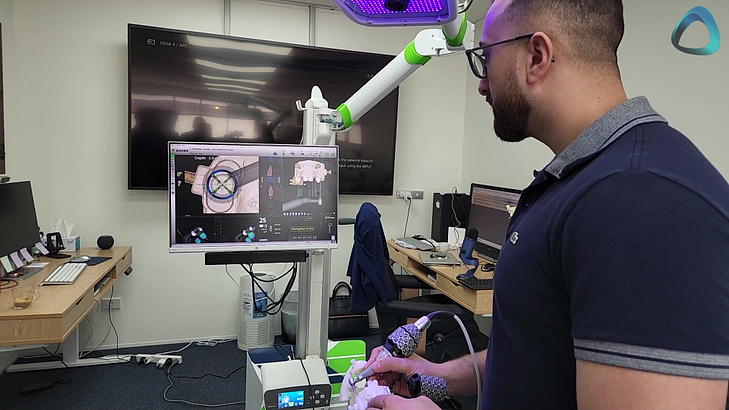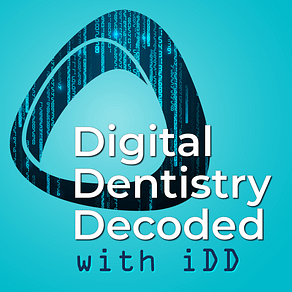I was recently invited to join Straumann’s ProTalk podcast at IDS 2025, and what started as a standard interview quickly turned into one of the most candid and unfiltered conversations I’ve had in a while.
Together with Dr. George Raeber and Dr. Florian Kirsch, we dived deep into the state of digital dentistry. The good, the bad, and the downright chaotic. We covered everything from scanner overload and AI hype to why the SprintRay partnership actually makes sense and what really matters when choosing technology for your practice.
If you're tired of the marketing fluff and want to hear some real talk about where our industry is headed, this one’s worth a listen.
Note: This conversation was recorded live at IDS 2025 with some background noise, but trust me, the insights are worth it.
Read the written summary of the podcast below.
The Digital Dentistry "Beautiful Mess" We Need to Talk About
When George asked me about the state of our industry, I didn't hold back:
"I feel like the entire industry right now... it's a bit of a mess. I don't think something as niche as dentistry needs 30 intraoral scanners... and like 10 different AI and 260 printers."
Now, before the scanner companies start sending me angry emails, hear me out. Competition is fantastic - it's why we're not still paying $100,000 for scanners like we were a decade ago. But at what point does choice become chaos?
I've tested almost all of these scanners (yes, really), and here's the truth: anything mid-tier and above - let's say over $10,000 - performs similarly for most clinical applications. We're talking 20-30 micron accuracy across the board. The real differences? They're in the software, the workflows, and how well they integrate with everything else in your practice.
You know what's funny? I mention a story to the hosts that back at IDS 2019, I was nobody in this industry. I went to the Medit booth - just wanted to interview them about their new product. You know what happened? I got kicked out. Literally. Fast forward to today, and I'm having strategy discussions with exec level people of these same companies.
The lesson? Sometimes being persistent and credible pays off.
Why Your Lab Needs to Digitize Yesterday (Not Tomorrow)
During the conversation, Florian asked me what I'd tell a 35-year-old starting a dental lab today. My answer was simple:
"Digitize. Digitize a hundred percent."
If you're still clinging to analog techniques thinking they'll always have a place, you're setting yourself up for obsolescence. Unless you want to be the artisan layering ceramics for high-end cosmetic cases (which is fine, but it's a shrinking market), you need to learn CAD software. Yesterday.
The technician workforce is shrinking - it's sad, but it's reality. AI isn't going to replace technicians, but it will make the remaining ones exponentially more efficient. A single crown shouldn't require human intervention from start to finish. If ChatGPT can pass the bar exam, I'm pretty sure AI can design a simple crown. And more.
But here's the kicker - most universities still don't have proper digital dentistry curriculum. When I graduated less than 10 years ago, I was doing amalgam fillings! My father laughed when I asked where the amalgam was I joined his practice after uni. The real learning starts after dental school, which is a problem we need to fix.
The Platform Paradox Nobody Wants to Address
Now, this is where I might ruffle some feathers.
Every company at IDS was talking about their "platform." Cloud this, AI that, seamless integration here, revolutionary workflow there. And you know what? I'm not exactly buying it. Neither are most clinicians.
"I don't think the compelling things are cloud sharing and collaboration... this is not the key. I don't know what the key is. But I don't think that's the compelling thing (to get people to buy into platforms)."
To be frank, I think the industry sometimes creates problems just to sell solutions. It makes for a nice PowerPoint presentation, but when I'm in my operatory with a patient in the chair, I need solutions that actually solve my problems in the clinic - not create new ones.
The SprintRay-Straumann Partnership
Speaking of solutions, let me talk about something that actually impressed me.
When Straumann announced their partnership with SprintRay, my first thought was "wow" they are moving fast.
"I think it's probably... one of the smartest things you guys could have done. You picked the restorative printer."

Here's why this matters: SprintRay dominates chairside printing for a reason. Software, workflow and formfactor etc.
But let's talk about the elephant in the room - resin crowns. Are they as good as ceramic? No. Will they ever be? Probably not. But here's the real question: are they good enough? For posterior restorations that can last 5-10 years? I'd say we're getting there. The main issues remain which are staining and wear, but the gap isn't between resin and ceramic anymore - it's between what's acceptable and what's not.
What's interesting is how the competition is responding. Asiga just released their pod solution - clearly going after the Midas market. This is good! Competition drives innovation. But at the end of the day, for chairside printing, SprintRay has nailed the clinician workflow in a way others haven't.
Scanner Accuracy: The Conversation Nobody's Having
You want to know something that drives me crazy? All these marketing brochures about scanner specifications, but nobody talks about real-world accuracy differences.
So let me break it down for you - when I tested them all for full arch implant scanning using horizontal scan bodies:
- Premium scanners (>$20,000): 20-30 micron full-arch accuracy
- Mid-tier scanners ($13,000-$20,000): Still 20-30 microns (surprised?)
- Budget scanners (<$3,000): Can be as bad as 100+ microns
Not all scanners are created equal, despite what the marketing tells you. And this discussion isn't even happening at most dental meetings.
The Future Isn't in Hardware - It's in Intelligence
The hardware game? It's getting boring. Smaller, lighter, wireless - we get it. Every scanner is now 50 grams lighter than the last one. Who cares?
"I truly believe it's going to be mostly software and workflow innovation going forward. There's a lot that can be done still with scanner software."
Imagine this: You prep a crown, and your scanner immediately tells you if you have sufficient reduction. Or it highlights unclear margins in real-time. That's the innovation that actually matters to clinicians, not shaving another 20 grams off the wand weight.
As Rune Fisker likes to say (and I quoted him in the podcast), we're moving toward an "inspect and correct" workflow. AI designs, you inspect, you make minor corrections if needed. That's the future. And honestly? Some labs are already there with tools like 3Shape Automate and Dentbird.
Speaking of innovation, let's talk about something that's actually revolutionary: horizontal scanbodies. Shining 3D Elite caught everyone by surprise with their photogrammetry integration, but I believe horizontal scanbodies systems like TruAbutment are the real future.
In my testing (and I'm hoping to publish this data soon), these are achieving the accuracy we need for full-arch cases without the extra hardware. Photogrammetry? It was a transitional solution. The smart photogrammetry companies are already pivoting - look at PIC with their iPhone integration.
3Shape's TRIOS 6 is heading in the right direction too - integrated diagnostics, everything in one place after you scan. Sure, it's a gamble at the high price they are asking but at least they're thinking about workflow, not just specs.
Dynamic Navigation and Surgical Robotics: The Reality Check
When George brought up digital surgery and dynamic navigation as the next big thing, I had to provide a reality check.
These systems are incredible - I've used X-Guide and Navident, and they're amazing technology. But here's the thing:
"Surgical guides are so good now and so cheap... we still don't have close to mass market on surgical guides. Maybe it's 10%."

If only 10% of implants are placed with surgical guides that cost a few hundred dollars, what percentage will use a $20,000+ dynamic navigation system? It's not that the technology doesn't work - it's that we need a complete culture shift in how implant surgeons view guided surgery.
Florian also asked about remote monitoring - will it expand beyond orthodontics? Dental Monitoring became dentistry's first unicorn for a reason. It works brilliantly for clear aligners. But for general dentistry? I'm skeptical. You can't diagnose much without radiographs, and patients don't necessarily want us checking in on them constantly. Some things need to stay in the operatory in my opinion but this could change.
One Scanner Per Practice? The Truth About Equipment Needs
Here's something that might surprise you: Despite having access to over 30 scanners, I don't believe in the "scanner in every operatory" dream. When Florian asked me about this, I was clear:
"I just feel like one or two scanners in a clinic is plenty."
Unless the scanner is built directly into the dental chair (now there's an idea for you manufacturers), rolling a cart between rooms is perfectly efficient. At some point when prices decrease enough, the one scanner in each operatory dream may happen.
Looking Ahead: Consolidation Is Coming
Make no mistake, the current situation isn't sustainable.
Companies can't keep paying for massive IDS booths while barely selling products. R&D requirements are going up, not down. Features like horizontal scanbodies aren't simple to develop, and they're separating the serious players from the rest.
I predict we'll see significant consolidation in the next 2-3 years. And honestly? That's probably a good thing. We need fewer, better products - not more options that confuse clinicians and fragment the market.
The Bottom Line
After almost an hour of conversation (which flew by, by the way), here's what I want you to take away:
- The industry needs solutions, not features. Stop trying to sell me on cloud storage and start solving my actual clinical problems.
- If you're a clinic or lab, digitize now. This isn't optional anymore.
- AI is coming whether you trust it or not. Just like scanners 10 years ago, resistance is futile.
- Choose your technology partners wisely. Integration matters more than having the "best" individual components.
- Don't buy into every trend. Evaluate what actually improves your clinical outcomes and practice efficiency.
The conversation reminded me why I started iDD in the first place - to cut through the marketing noise and tell clinicians what actually matters.
Sometimes that means being critical. Sometimes it means admitting when companies get it right. But it always means being honest.
What do you think? Is our industry really the "beautiful mess" I described, or am I being too harsh?
Drop me a comment below - I'd love to hear your perspective.

